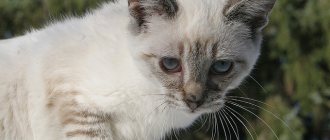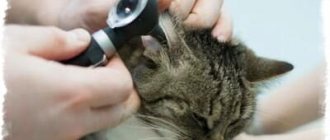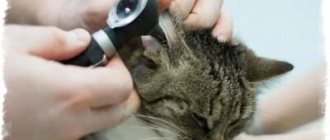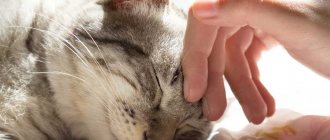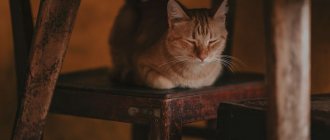Natural curiosity often plays a cruel joke with furry pets. Young kittens, who have no life experience yet, try everything they can get their teeth into.
Curiosity often leads to swallowing inedible objects. Another reason is boredom. If you don’t approach your pet and don’t play, then he will entertain himself with extraneous things. It is important for the owner to know if the cat has eaten gum, what to do and how to help.
What to do if your cat swallows a hair elastic
In general, cats are pickier and pickier eaters than dogs, but there is one item to which this rule does not apply: hair ties. Some cats are particularly attracted to scrunchies, likely due to their stretchy texture and bouncy/bouncy nature. Most cats will only play with hair accessories, but some may eat them, making them an item that should not be left lying around due to the risk of ingestion.
Basics of prevention:
- Teach your child to avoid head-to-head contact when playing with classmates and other activities.
- Teach your child not to share personal items such as hats, scarves, coats, combs, headphones and hair accessories.
- It is advisable that girls attend educational institutions with their hair tied up (braids).
Important! Unfortunately, it is simply impossible to eliminate all routes of transmission of lice. So it is simply necessary to regularly examine children's heads.
Symptoms of ingesting a hair tie
Unless ingestion is witnessed, it may be difficult to know if your cat has eaten one of these foods until they begin to show signs of illness.
The most common clinical signs of hair tie ingestion include:
- Vomit
- Lack of appetite
- Lethargy/hiding
If you see your cat eating a hair tie, it should be taken to the vet immediately as it can cause vomiting if necessary. This is the best-case scenario because the hair tie may break out and no further testing or treatment will be required. Cats with clinical signs may require further testing to determine the cause.
Tags
Cats Cat examination Consultation with a veterinarian Consultation with a veterinarian Our doctors Call a doctor
consultationdoctorquestionanswergynecologycasesletrubberkinelfeedbackclinicneedourarticlesgiveyoudogsdiseasesneurologyservicesillnesstherapymonthsdermatologychildreneatbackallergologistwaspersonsurgeryspecialistsnoanimalshousebighealthonlyimmunologistendocrinologistgoodrecordselfonlinepeoplepulmonologistlorinologychildrenvitaminswillthemworkgastroenterologistsee oilveterinaryjunorthopedicspediatricsnothingdentistologyproctologistnephrologistresults
Diagnostics
Additional diagnostics may include:
- Radiographs/X-rays. Hair ties can be seen on x-rays and have a very distinct appearance, which aids in diagnosis.
- Ultrasound. This may help rule out other causes of vomiting/lack of appetite.
- Bloody work. It evaluates the liver, kidneys, electrolytes, and cell counts and can be used to rule out a systemic problem.
Treatment measures
Depending on the location of the hair tie, different treatment recommendations may be given. Endoscopy is recommended if the hair ties are in the stomach and do not pass through the small intestine. This is a procedure in which the cat is given anesthesia, a videoscope is inserted into its mouth and advanced into its stomach. The endoscope can visualize the hair ties and make removal easier. Endoscopy can also help look for other pathologies of the stomach or esophagus.
If hair ties are in the small intestine, they cannot be easily removed by endoscopy and must be removed by abdominal surgery. In this case, the cat is given anesthesia and an incision is made along the abdomen. The surgeon evaluates all abdominal organs and isolates where the hair bands are located, makes an incision over the area, and removes foreign material.
About 20 hair ties were surgically removed from the cat.
Cats that eat hair ties can become seriously ill, depending on how much they eat and how long their clinical signs last. Cats that vomit and go several days without eating may become dehydrated, making their illness worse. Those who receive medical attention may make a full recovery from hair tie ingestion if treatment is started immediately after clinical signs appear.
At any time, ask your veterinarian to examine your cat if she is showing signs such as vomiting, lack of appetite, lethargy, or secretiveness. Additionally, if you suspect your cat may have eaten hair gum, ask your veterinarian to examine her so they can conduct further testing and come up with a treatment plan.
Source
What to do with your hair?
- Examine all family members for infection.
- Apply the product according to the instructions on the package. You may need to repeat the lotion or shampoo treatment after 7-10 days.
- After treating with shampoo or lotion, take a small section of hair and use a rough cloth to rub the section with the cloth, trying to remove the nits from the hair. Repeat this until your hair is completely free of nits. You can also use a fine-grained hair comb (this often comes in a set with lotion or shampoo. Or ask your pharmacy about it).
- Comb wet hair, not dry hair.
What to do if a cat swallows an elastic band or soft wire?
Ingestion of foreign objects by a cat is a very common reason for visiting veterinary clinics. This happens most often due to the specific structure of the cat's tongue, completely covered with the so-called horny papillae, curved towards the pharynx - they help the cat to effectively care for its fur, but do not allow it to spit out small objects that fall into the mouth, for example, during play . Most often, cats swallow small parts of toys, threads, thin elastic bands, and soft wires.
Prevention
Every owner should know that the entry of a foreign object into the animal’s body (ear, nose, intestines) poses a serious danger not only to the normal functioning of the body, but can also cause death.
It is necessary to adhere to a number of measures to help minimize the risk of foreign objects entering the cat's body. It is important to keep the living space where your pet is often kept clean and in order. Remove small objects (sewing accessories, fishing gear) from the cat’s reach.
The pet's diet should not contain sharp objects (chicken or fish bones), and toys for the animal must be chosen carefully, avoiding the presence of small parts that can be bitten off and subsequently swallowed.
You can prevent a foreign body from getting into your cat's ear canal by regularly examining the animal, as well as by constantly cleaning the ears using special means.
In what cases, if a cat has swallowed a wire, should you not hesitate?
Seek veterinary help immediately if you notice the following symptoms in your cat after suspected ingestion of a rubber band or soft wire:
- refusal to eat;
- repeated vomiting (often immediately after trying to eat or drink);
- lack of stool;
- lethargy, apathy, desire to hide;
- painful reaction to feeling the abdomen.
In this case, under no circumstances should you give a laxative, Vaseline oil or do an enema! It is also not recommended to force feed or water the animal - such attempts will only cause even more severe vomiting, which will increase the dehydration of the cat’s body and worsen its condition.
There is no conservative, drug treatment for foreign bodies. If the object does not leave the body on its own, it means that the pet will have to undergo an emergency operation - laparotomy. Do not delay treatment under any circumstances - if the intestines are completely blocked, the animal may die on the second day.
Preventing your cat from swallowing foreign objects is much easier than treating the consequences later, so do not allow your pet to play with small inedible objects and always make sure that they are not in the public domain.
Source
When can signs be deceiving?
The symptoms of cat allergy in children and adults are very similar to a number of other allergic reactions. Therefore, do not rush to give your pet away, because the reason may not be his:
- The reaction can be caused not by the pet, but by its accessories: food, shampoo, litter
Read also: There is not enough water in the well, what to do?
- Animals that walk outside can carry particles of pollen or mold on their fur, which are strong allergens.
- A cat can infect its owner with an infection (lichen, scabies mite), which causes symptoms similar to allergies
Therefore, you should not engage in self-diagnosis, but rather consult a doctor. He will prescribe diagnostics (skin tests or blood tests) that will accurately determine the cause of the allergic reaction.
When to see a doctor
A cat eats something inedible not always in front of its owner. Therefore, it is impossible to immediately discover what happened. You need to focus on your pet's behavior. Small, delicate things independently leave the body through the gastrointestinal tract. This usually takes up to 3 days. The cats do not show what happened in any way, eat well, and behave actively.
- increased salivation – due to blockage of the esophagus;
- cough, wheezing, blue tongue - when localized in the pharynx;
- restlessness, neck craning, hunched back;
- abdominal pain, bloating, accumulation of gases;
- lethargy, apathy, weakness, inactivity;
- vomiting with belching, problems with bowel movements;
- lack of appetite, thirst, exhaustion of the body.
The listed signs appear with the development of obstruction and damage to organ walls. If the condition does not return to normal within 3-4 days after the cat ate the money or hair elastic, the veterinarian decides what to do. The owner needs to get the pet to the clinic as quickly as possible.
How can I help you
The appointment at the veterinary clinic begins with the collection of information about the situation that has occurred, examination and palpation of the abdominal wall. If the localization cannot be determined, then an x-ray is performed, with or without a contrast agent, gastroscopy, or ultrasound. These methods are often enough if the cat has eaten gum. Sometimes the veterinarian does a blood or urine test.
- Give Vaseline oil if your pet is feeling well. Helps the object found in the intestines to pass naturally.
- Gently pull with tweezers, hand or endoscope if part of the elastic is visible in the throat or anus.
- Operation. Enterotomy is an opening of the small intestine. Gastrotomy and esophagotomy - to remove gum from the stomach and esophagus.
After surgery, a fasting diet for 1 day is recommended. Next, liquid food is given in small portions. Infusion therapy is performed if the animal appears weakened and dehydrated. Veterinarians prescribe antibiotics. If the obstruction in the gastrointestinal tract was complicated, the patient is left in the hospital on parenteral nutrition.
If a cat ate a rubber band, what not to do is an equally important question. To prevent complications, it is forbidden to give yourself a laxative or Vaseline, do enemas, force feed or drink. It is better to avoid such a situation altogether. It is enough not to scatter small things within your pet’s reach.
Source
Treatment
After a pet has eaten an inedible object in front of the owner, you must immediately go to the veterinary clinic. This will allow you to take the necessary measures as quickly as possible, preventing the development of dangerous complications. A diagnosed foreign body in the digestive tract that has caused intestinal blockage requires immediate surgical intervention.
Removal of a foreign object from the intestine occurs under general anesthesia using diagnostic laparoscopy. During the manipulation, the swallowed object is removed, and parts of the necrosis are resected.
A foreign body in the stomach detected during X-ray is also recommended to be removed during gastroscopy. The stomach wall is incised (gastrotomy) and the object is removed. Next, sutures are placed on all the cut layers, and the cat’s stomach is returned to its place.
A diagnosed foreign body in the esophagus can be removed by pushing it into the stomach during endoscopy. But if the foreign object is large, an incision is made in the esophagus if a perforation of the walls of the food tube is detected.
A foreign body in the ear is removed under local anesthesia, in rare cases using general anesthesia. As a rule, if a short period of time has passed after a foreign object entered the ear canal and it did not have time to penetrate deeply, there will be no problems with removal.
Surgical interventions performed on internal organs (esophagus, stomach, intestines) require proper organization of postoperative care. First of all, the animal is prescribed a starvation diet for at least a day. Next, you need to gradually introduce food, preferably liquid, often and in small portions.
Severe dehydration implies the appointment of infusion therapy. Any surgical intervention requires antibiotic therapy. This allows you to avoid serious complications when a bacterial infection occurs.
What to do if your cat swallows a foreign body?
If a cat has swallowed a foreign body, its condition is considered dangerous. The owner must understand what signs are characteristic of the condition - frequent vomiting, refusal to eat, abdominal pain, decreased or lack of activity. The owner should also know how to provide first aid to the pet, provide rehabilitation and diet after the veterinarian makes a diagnosis and performs surgery.
According to veterinarian A. Joost, the most dangerous are apricot or peach pits, which are not visible on an x-ray, but have sharp edges that injure the cat’s gastrointestinal tract.
How to live with a cat if allergies are confirmed?
Based on the diagnostic results, it turned out that your body reacts specifically to the cat, but you do not want to part with your pet. What to do? By following a number of recommendations, you can reduce the likelihood of exacerbation of allergies:
- Try to pet the animal less, do not kiss it. After being held, wash it with soap.
- Regularly give your cat water treatments and brush her
- Replace the open tray with a closed one
- Do wet cleaning as often as possible, at least twice a week
- Don't forget to ventilate the rooms several times a day.
- Air washers will help clean the room from flying microparticles
Causes of ingestion of foreign bodies
A cat is a born hunter who, having caught prey, wants to chew it and eat it. A curious pet pays attention to everything that rustles and rolls, so often a small ball, foam rubber, feather, or string becomes a “toy.” A cat may accidentally swallow foreign objects. Cats especially like the New Year's “rain”, which is a thin metal ribbon. Some pets who lack minerals happily swallow it. Animals are also partial to shiny and ringing objects: hooks, hairpins, needles, buttons. Most often, the owners are to blame for leaving their pet alone for a long time, carelessly placing foil, candy wrappers, chewing gum, and hair elastic in places accessible to the cat, and not providing the pet with special pet toys. Young animals and kittens are especially affected.
Why are foreign objects dangerous?
Veterinarians consider it most dangerous if a cat has eaten rope, thread or tape. A linear foreign body can pull the intestines into an “accordion”, which leads to rupture of organ tissue. Long flexible objects can tighten the intestine, which provokes acute obstruction and death. In addition, the presence of a foreign body in a cat’s stomach causes the following serious conditions:
- Tissue death. Due to poor circulation, zones of necrosis form in damaged areas of organs.
- Mechanical damage. If glass or rain hits, the intestinal walls are constantly injured, causing internal bleeding.
- Intestinal obstruction. The ribbon, ball, or hair tie are not digested and get stuck in the intestinal lumen, preventing food from moving through.
- Dehydration. Due to frequent vomiting, the cat’s body loses a lot of fluid, and the incoming water is not absorbed due to a foreign object.
- Peritonitis. The walls of the organ are perforated by the sharp edges of foreign bodies, which provokes death.
- Exhaustion. The cat cannot eat properly and does not receive the necessary substances and vitamins, which leads to disruption of all body functions.
- Ulcer. Plastic, cotton swabs and other objects constantly irritate the mucous membrane of the gastrointestinal tract, which is dangerous due to the violation of the integrity of the membranes and the appearance of ulcerations.
Symptoms of a foreign body
The most characteristic signs are the following:
- pain when swallowing and severe pain in the esophagus;
- sometimes nausea, vomiting, pain, bleeding (indicates damage to the gastric mucosa);
- sudden sharp pain during bowel movements (this means that the foreign body has already reached the rectum);
- pain in the anus;
- feeling of “fullness” in the intestines;
- false urge to defecate, etc.
The appearance of other symptoms depends on the size and shape of the foreign object that has entered the body, the time it remains in the digestive tract, as well as whether an infection has entered the body and whether any complications have arisen.
1 KARL STORZ Rectoscope
Symptoms: how to recognize pathology?
If a cat or kitten swallows a cotton swab, chewing gum, ribbon, or rubber toy and it gets stuck in different parts of the gastrointestinal tract, the symptoms are as follows:
- pain in the abdomen, in which the pet tries to curl up;
- refusal of food;
- frequent vomiting with almost no food, sometimes with blood;
- drowsiness;
- loss of activity, reluctance to play;
- constipation, scanty stool;
- slight increase in temperature, hot dry nose;
- weight loss;
- pallor and dryness of the oral mucosa due to dehydration.
Return to contents
First aid: what to do?
The owner is prohibited from trying to remove a foreign object on his own by pouring in vegetable oil or a large amount of water. Do not induce vomiting because the moving ball, hair tie, or band may become dislodged and make the condition worse. Algorithm of actions:
- Provide the animal with complete rest.
- Carefully transfer to a carrying cage.
- Give a sedative if the cat is rushing about in fear - “Cat Bayun”, “Fitex”, “Stop-stress”.
- Urgently take your pet to the veterinary clinic.
Return to contents
Operations to remove a foreign object
Surgery is performed after a foreign object is detected in a specific part of the stomach or intestines. Before surgery, the cat's condition is stabilized with saline solution, since the body may be weakened by dehydration. After this, under general anesthesia, an incision is made into the skin and organ, the foreign body is removed, as well as areas of necrosis or perforation zones. After removal, the tissues are sewn together and sutures are applied. If a body gets stuck in the esophagus and the integrity of the organ is compromised, an esophagotomy is performed. Treatment also includes a gastrotomy, where the veterinarian pushes the stuck object from the esophagus into the stomach and removes it from there. To prevent suppuration and internal bleeding, it is recommended to inject with appropriate medications.
Diagnostics in a veterinary clinic
Having discovered one of the above signs of a foreign body entering the body in their cat, the owner is obliged to seek qualified help without trying to eliminate the foreign object on their own.
In a veterinary clinic, anamnesis and a general clinical examination are performed. In addition, a number of special studies are prescribed, among which the main place is given to radiography.
Survey radiography is carried out in several projections, which makes it possible to identify the location of a foreign object, as well as its structure (for radiopaque objects - needles, paper clips, etc.).
If an animal has swallowed a plastic object, thread, or New Year's tinsel, it is necessary to take an x-ray using a special substance injected into the patient's body.
Carrying out ultrasound diagnostics of the digestive tract makes it possible to visualize possible intestinal obstruction, as well as determine the degree of contractions to the intestinal loops. Some veterinary clinics perform endoscopy of the digestive tract, but only if no more than 4 hours have passed since the ingestion of a foreign object.
Rehabilitation
After surgery on the stomach or intestines, a sick cat should stay in the hospital for 2-3 days under the supervision of specialists. It is dangerous to take your pet home right away, since complications may develop, and there is no one to provide qualified assistance. When a pet can be adopted, the following conditions should be created for it:
Some cases require feeding through a pipette or tube during the rehabilitation period.
- Blanket. Necessary to protect the sutures from the cat’s rough tongue, dust and dirt getting into the wound.
- Sun lounger. It should have low sides or a U-shape to make it easy for the animal to enter.
- Help. A sick cat needs round-the-clock care, so the owner must temporarily put everything aside. The seams should also be treated regularly.
- Peace. Until the pet recovers, you should not expose it to stress and invite guests.
- Nutrition. Often during the rehabilitation period it is necessary to feed through a pipette or tube.
Return to contents
Therapeutic diet
Recovery includes proper nutrition for the cat after intestinal surgery. The animal cannot be fed for the first 24 hours after the intervention. Later, you can give liquid and soft food, food soaked in water. It is better to choose holistic food products or premium brands with the Sensitive label, as well as high-quality canned cat food, which should be crushed until smooth. If it is difficult for your pet to move, it is recommended to feed him by hand. When the animal gets stronger, they offer twisted lean meat (store-bought minced meat is not suitable), oatmeal or rice porridge in water without salt.
Source


